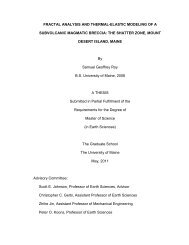Jumars, P.A. - University of Maine
Jumars, P.A. - University of Maine
Jumars, P.A. - University of Maine
Create successful ePaper yourself
Turn your PDF publications into a flip-book with our unique Google optimized e-Paper software.
NEW SPECIES OF NORTH PACIFIC DORVILLEID POLYCHAETES 115<br />
The hard pharyngeal parts <strong>of</strong> D. gardineri differ very little from those <strong>of</strong><br />
D. rubrovittata in their arrangement . Denticulations <strong>of</strong> the carriers are very<br />
much weaker in D . gardineri, and denticle shapes differ somewhat in the two<br />
species, but this difference is not as great as that between some pairs <strong>of</strong> species<br />
in the group <strong>of</strong> subbiramous dorvilleids without furcate setae and without a<br />
nuchal papilla, e .g., D . cerasina and D . rubrovittata . (See Fauchald, 1970, for a<br />
description <strong>of</strong> the jaws in D . cerasina.) Therefore, the inclusion <strong>of</strong> Staurocephalus<br />
(Dorvillea) gardineri in Dorvillea is favoured here .<br />
Distribution . The species is recorded from East Africa at Kuwait and Wasin,<br />
from the Maldive Islands, and from Bikini Atoll . It is thus a tropical,<br />
shallow-water Indian Ocean species .<br />
Dorvillea baba sp . nov .<br />
(Fig . 6)<br />
Material examined. Five specimens were obtained in three samples from the<br />
San Diego Trough as follows : one in SIO J22 (holotype, AHF Poly . 1074),<br />
three in SIO J15 (paratypes, AHF Poly . 1075), and one in SIO H22 (paratype,<br />
AHF Poly . 1076') . Two <strong>of</strong> the examples from SIO J15 and one from SIO H22<br />
were cleared in xylol and mounted whole after being dorsally incised .<br />
Description . The holotype is 3 .3 mm long and 0 .34 mm wide . It is complete<br />
and bears 44 setigers . The prostomium is depressed hemispherical (Fig . 6A, C) .<br />
Near its posterior margin are a pair <strong>of</strong> well developed, subulate palps laterally<br />
and a pair <strong>of</strong> slightly longer antennae dorsolaterally . The latter are basically<br />
cirriform but carry rapidly tapering tips . Eyes are absent . Lappet-like ventral<br />
cirri are present from the first parapodium . From the second parapodium, a<br />
digitiform dorsal cirrus with an enclosed acicula is present, with or without a<br />
slight distal swelling, but without a true cirrostyle . Neuropodia are biacicular<br />
(Fig . 6E) ; the larger upper acicula divides the setal fan into two fascicles . The<br />
dorsal fascicle consists <strong>of</strong> an approximately elliptical array <strong>of</strong> smooth<br />
capillaries, while the ventral fascicle consists <strong>of</strong> a linear array <strong>of</strong> smooth,<br />
heterogomph spinigers (Fig . 6A, D) . Setae decrease in abundance in far<br />
posterior setigers . The pygidium (Fig . 6B) bears numerous supra-anal papillae<br />
and a pair <strong>of</strong> multiarticulate, cirriform appendages ventrolateral to the anal<br />
opening .<br />
The maxillary carriers are fused together with both pairs <strong>of</strong> basal plates<br />
(Fig . 6F) . All denticles are bird-wing shaped with a main fang distally and fine<br />
denticulations along the medial edge . Each half <strong>of</strong> the mandible (Fig . 6G) bears<br />
a thin, transparent area surrounded by thicker, darker material and is bifurcate<br />
anteriorly and denticulate anteromedially .<br />
The gut is filled with fine, particulate, orange matter . The distinctive color<br />
corresponds to that <strong>of</strong> a sympatric species <strong>of</strong> astrorhizid foraminiferan which<br />
bears abundant epifauna . Both this circumstantial evidence and the shape <strong>of</strong><br />
D . batia dentides suggests that it may graze this epifauna .<br />
Remarks . Dorvillea baba differs from other known members <strong>of</strong> the genus in<br />
the lack <strong>of</strong> denticulations along any <strong>of</strong> its setae, in the shape <strong>of</strong> its denticles, in<br />
the presence <strong>of</strong> spinigers rather than falcigers, and in the shape <strong>of</strong> its mandibles .<br />
It is named for the bushy appearance its numerous setae give .
















